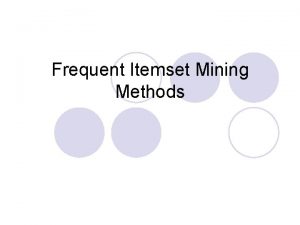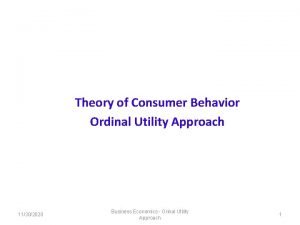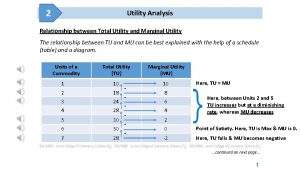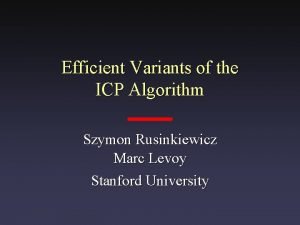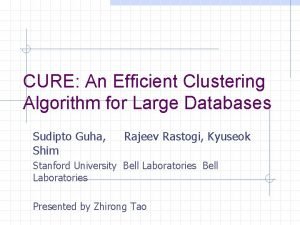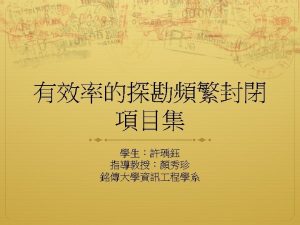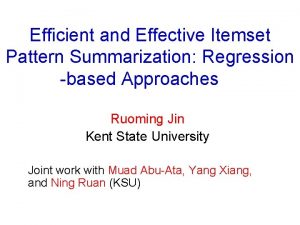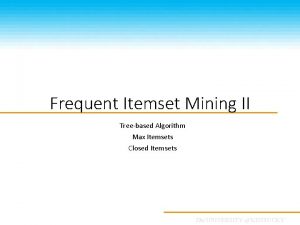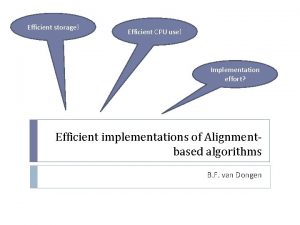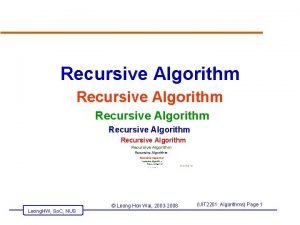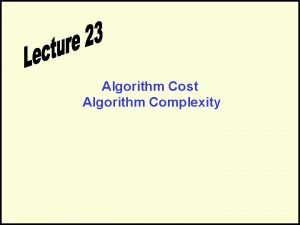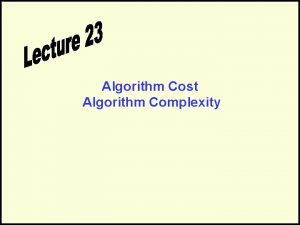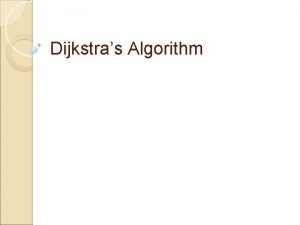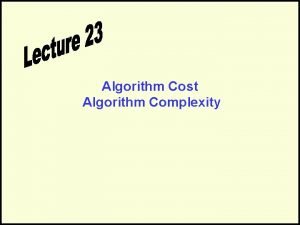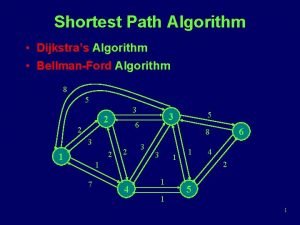UPGrowth An Efficient Algorithm for High Utility Itemset










































- Slides: 42

UP-Growth: An Efficient Algorithm for High Utility Itemset Mining Vincent S. Tseng 1, Cheng-Wei Wu 1, Bai-En Shie 1, and Philip S. Yu 2 1 Department of Computer Science and Information Engineering, National Cheng Kung University, Taiwan, ROC 2 Department of Computer Science, University of Illinois at Chicago, Illinois, USA Intelligent Data. Base System Lab, NCKU, Taiwan

Introduction Frequent itemset mining is a popular technique in data mining community. Example application: discover the itemsets which are frequently purchased by customers Insufficiency in real applications In market analysis May lose infrequent but valuable itemsets. May present too many frequent but unprofitable itemsets to users. The purchased quantities and unit profits of the items are not considered. Hence, the important itemsets with high profits can’t be found. 2 Intelligent Data. Base System Lab, NCKU, Taiwan

High Utility Itemset Mining Utility of an item ip in the transaction Td u(ip , Td ) = q(ip, Td ) × p(ip) i. e. , u({A}, T 1) = 1 × 5 = 5 Utility of an itemset X in the transaction Td . i. e. , u({AD}, T 1) = u({A}, T 1) + u({D}, T 1) =5+2=7 Utility of an itemset X in the database . Transactional Database TID Transaction T 1 T 2 (A, 1)(C, 1)(D, 1) (A, 2)(C, 6)(E, 2)(G, 5) (A, 1)(B, 2)(C, 1)(D, 6)(E, 1)(F, 5 ) (B, 4)(C, 3)(D, 3)(E, 1) (B, 2)(C, 2)(E, 1)(G, 2) T 3 T 4 T 5 Items and their unit profits Item A B C D E F G Unit Profit 5 2 1 2 3 1 1 i. e. , u({AD}) = u({AD}, T 1) + u({AD}, T 3) = 7 + 17 = 24 High Utility Itemset An itemset X is called a high utility itemset iff 3 u(X) > min_utiliy i. e. , min_utility = 30, {B}: 16 is a low utility itemset ; {BD}: 30 is a high utility itemset Intelligent Data. Base System Lab, NCKU, Taiwan

High Utility Itemset Mining Utility of an item ip in the transaction Td u(ip , Td ) = q(ip, Td ) × p(ip) i. e. , u({A}, T 1) = 1 × 5 = 5 Utility of an itemset X in the transaction Td . i. e. , u({AD}, T 1) = u({A}, T 1) + u({D}, T 1) =5+2=7 Utility of an itemset X in the database . Transactional Database TID Transaction T 1 T 2 (A, 1)(C, 1)(D, 1) (A, 2)(C, 6)(E, 2)(G, 5) (A, 1)(B, 2)(C, 1)(D, 6)(E, 1)(F, 5 ) (B, 4)(C, 3)(D, 3)(E, 1) (B, 2)(C, 2)(E, 1)(G, 2) T 3 T 4 T 5 Items and their unit profits Item A B C D E F G Unit Profit 5 2 1 2 3 1 1 i. e. , u({AD}) = u({AD}, T 1) + u({AD}, T 3) = 7 + 17 = 24 High Utility Itemset An itemset X is called a high utility itemset iff 4 u(X) > min_utiliy i. e. , min_utility = 30, {B}: 16 is a low utility itemset ; {BD}: 30 is a high utility itemset Intelligent Data. Base System Lab, NCKU, Taiwan

High Utility Itemset Mining Utility of an item ip in the transaction Td u(ip , Td ) = q(ip, Td ) × p(ip) i. e. , u({A}, T 1) = 1 × 5 = 5 Utility of an itemset X in the transaction Td . i. e. , u({AD}, T 1) = u({A}, T 1) + u({D}, T 1) =5+2=7 Utility of an itemset X in the database . Transactional Database TID Transaction T 1 T 2 (A, 1)(C, 1)(D, 1) (A, 2)(C, 6)(E, 2)(G, 5) (A, 1)(B, 2)(C, 1)(D, 6)(E, 1)(F, 5 ) (B, 4)(C, 3)(D, 3)(E, 1) (B, 2)(C, 2)(E, 1)(G, 2) T 3 T 4 T 5 Items and their unit profits Item A B C D E F G Unit Profit 5 2 1 2 3 1 1 i. e. , u({AD}) = u({AD}, T 1) + u({AD}, T 3) = 7 + 17 = 24 High Utility Itemset An itemset X is called a high utility itemset iff 5 u(X) > min_utiliy i. e. , min_utility = 30, {B}: 16 is a low utility itemset ; {BD}: 30 is a high utility itemset Intelligent Data. Base System Lab, NCKU, Taiwan

High Utility Itemset Mining Utility of an item ip in the transaction Td u(ip , Td ) = q(ip, Td ) × p(ip) i. e. , u({A}, T 1) = 1 × 5 = 5 Utility of an itemset X in the transaction Td . i. e. , u({AD}, T 1) = u({A}, T 1) + u({D}, T 1) =5+2=7 Utility of an itemset X in the database . Transactional Database TID Transaction T 1 T 2 (A, 1)(C, 1)(D, 1) (A, 2)(C, 6)(E, 2)(G, 5) (A, 1)(B, 2)(C, 1)(D, 6)(E, 1)(F, 5 ) (B, 4)(C, 3)(D, 3)(E, 1) (B, 2)(C, 2)(E, 1)(G, 2) T 3 T 4 T 5 Items and their unit profits Item A B C D E F G Unit Profit 5 2 1 2 3 1 1 min_utility = 30 i. e. , u({AD}) = u({AD}, T 1) + u({AD}, T 3) = 7 + 17 = 24 High Utility Itemset An itemset X is called a high utility itemset iff 6 u(X) > min_utiliy i. e. , min_utility = 30, {B}: 16 is a low utility itemset ; {BD}: 30 is a high utility itemset High Utility Itemsets {BE}: 31, {BCE}: 37, {ACE}: 31 {BD}: 30, {BCD}: 34, {BDE}: 36 {BCDE}: 40, {ABCDEF}: 30 Intelligent Data. Base System Lab, NCKU, Taiwan

Main Challenge Main challenge in utility mining Downward closure property can’t be applied. A superset of a low utility itemset may be a high utility itemset. i. e. , {B}: 16 is a low utility itemset but {BD}: 30 is a high utility itemset Search space pruning is difficult. Transactional Database TID Transaction T 1 T 2 (A, 1)(C, 1)(D, 1) (A, 2)(C, 6)(E, 2)(G, 5) (A, 1)(B, 2)(C, 1)(D, 6)(E, 1)(F, 5 ) (B, 4)(C, 3)(D, 3)(E, 1) (B, 2)(C, 2)(E, 1)(G, 2) T 3 T 4 T 5 7 High Utility Itemsets min_utility = 30 {BE}: 31, {BCE}: 37, {ACE}: 31 {BD}: 30, {BCD}: 34, {BDE}: 36 {BCDE}: 40, {ABCDEF}: 30 Intelligent Data. Base System Lab, NCKU, Taiwan

Related Works Two-Phase Algorithm (Liu et al. , UBDM’ 2005) UMining Algorithm (Yao et al. , UBDM’ 2007) IIDS Algorithm (Li et al. , DKE’ 2008) CTU-Mine (Erwin et al. , PAKDD’ 2008) TWU-Ming (Le et al. , ACIIDS’ 2009) IHUP Algorithm (Ahmed et al. , IEEE Trans. TKDE’ 2009) 8 Intelligent Data. Base System Lab, NCKU, Taiwan

Related Work: IHUP Algorithm TID T 1 T 2 T 3 T 4 T 5 Transaction (A, 1)(C, 1)(D, 1) (A, 2)(C, 6)(E, 2)(G, 5) (A, 1)(B, 2)(C, 1)(D, 6)(E, 1)(F, 5 ) (B, 4)(C, 3)(D, 3)(E, 1) (B, 2)(C, 2)(E, 1)(G, 2) Intelligent Data. Base System Lab, NCKU, Taiwan

Related Work: IHUP Algorithm TID T 1 T 2 T 3 T 4 T 5 Transaction (A, 1)(C, 1)(D, 1) (A, 2)(C, 6)(E, 2)(G, 5) (A, 1)(B, 2)(C, 1)(D, 6)(E, 1)(F, 5 ) (B, 4)(C, 3)(D, 3)(E, 1) (B, 2)(C, 2)(E, 1)(G, 2) TU 8 27 30 20 11 l Compute the transaction utility for each transaction TU(Td) =u(Td, Td) i. e, TU(T 1) = u(T 1, T 1) = u({ACD}, T 1) = 8

Related Work: IHUP Algorithm TID T 1 T 2 T 3 T 4 T 5 Transaction (A, 1)(C, 1)(D, 1) (A, 2)(C, 6)(E, 2)(G, 5) (A, 1)(B, 2)(C, 1)(D, 6)(E, 1)(F, 5 ) (B, 4)(C, 3)(D, 3)(E, 1) (B, 2)(C, 2)(E, 1)(G, 2) TU 8 27 30 20 11 min_utility = 40 l Compute the transaction utility for each transaction TU(Td) =u(Td, Td) i. e, TU(T 1) = u(T 1, T 1) = u({ACD}, T 1) = 8 l Compute the TWU of an itemset TWU(X) = Items and their TWUs Item A B C D E F G TWU 65 61 96 58 88 30 38 i. e. , TWU(A) = u(T 1, T 1) + u(T 2, T 2) + u(T 3, T 3) = (8 + 27 + 30) = 65

Related Work: IHUP Algorithm TID T 1 T 2 T 3 T 4 T 5 Transaction (A, 1)(C, 1)(D, 1) (A, 2)(C, 6)(E, 2)(G, 5) (A, 1)(B, 2)(C, 1)(D, 6)(E, 1)(F, 5 ) (B, 4)(C, 3)(D, 3)(E, 1) (B, 2)(C, 2)(E, 1)(G, 2) TU 8 27 30 20 11 min_utility = 40 l Compute the transaction utility for each transaction TU(Td) =u(Td, Td) i. e, TU(T 1) = u(T 1, T 1) = u({ACD}, T 1) = 8 l Compute the TWU of an itemset TWU(X) = Items and their TWUs Item A B C D E F G TWU 65 61 96 58 88 30 38 i. e. , TWU(A) = u(T 1, T 1) + u(T 2, T 2) + u(T 3, T 3) = (8 + 27 + 30) = 65 l Remove unpromising items from each transaction i. e. , unpromising items are {F} and {G}, since their TWUs are less than min_utility

Related Work: IHUP Algorithm TID T 1 T 2 T 3 T 4 T 5 Transaction (A, 1)(C, 1)(D, 1) (A, 2)(C, 6)(E, 2)(G, 5) (A, 1)(B, 2)(C, 1)(D, 6)(E, 1)(F, 5 ) (B, 4)(C, 3)(D, 3)(E, 1) (B, 2)(C, 2)(E, 1)(G, 2) TU 8 27 30 20 11 min_utility = 40 l Compute the transaction utility for each transaction TU(Td) =u(Td, Td) i. e, TU(T 1) = u(T 1, T 1) = u({ACD}, T 1) = 8 l Compute the TWU of an itemset TWU(X) = Items and their TWUs Item A B C D E F G TWU 65 61 96 58 88 30 38 i. e. , TWU(A) = u(T 1, T 1) + u(T 2, T 2) + u(T 3, T 3) = (8 + 27 + 30) = 65 l Remove unpromising items from each transaction TID T 1 T 2 T 3 T 4 T 5 Reorganized Transaction TU Transaction (C, 1)(A, 1)(D, 1) (A, 1)(C, 1)(D, 1) 8 (C, 6)(E, 2)(A, 2) (G, 5) (A, 2)(C, 6)(E, 2) 27 (C, 1)(E, 1)(A, 1)(B, 2)(D, 6) (F, 5) 30 (A, 1)(B, 2)(C, 1)(D, 6)(E, 1) (C, 3)(E, 1)(B, 4)(D, 3) (B, 4)(C, 3)(D, 3)(E, 1) 20 (C, 2)(E, 1)(B, 2) (G, 2) (B, 2)(C, 2)(E, 1) 11 i. e. , unpromising items are {F} and {G}, since their TWUs are less than min_utility

Related Work: IHUP Algorithm TID T 1 T 2 T 3 T 4 T 5 Transaction (A, 1)(C, 1)(D, 1) (A, 2)(C, 6)(E, 2)(G, 5) (A, 1)(B, 2)(C, 1)(D, 6)(E, 1)(F, 5 ) (B, 4)(C, 3)(D, 3)(E, 1) (B, 2)(C, 2)(E, 1)(G, 2) TU 8 27 30 20 11 min_utility = 40 l Compute the transaction utility for each transaction TU(Td) =u(Td, Td) i. e, TU(T 1) = u(T 1, T 1) = u({ACD}, T 1) = 8 l Compute the TWU of an itemset TWU(X) = Items and their TWUs Item A B C D E F G TWU 65 61 96 58 88 30 38 i. e. , TWU(A) = u(T 1, T 1) + u(T 2, T 2) + u(T 3, T 3) = (8 + 27 + 30) = 65 l Remove unpromising items from each transaction TID T 1 T 2 T 3 T 4 T 5 Reorganized Transaction (C, 1)(A, 1)(D, 1) (C, 6)(E, 2)(A, 2) (C, 1)(E, 1)(A, 1)(B, 2)(D, 6) (C, 3)(E, 1)(B, 4)(D, 3) (C, 2)(E, 1)(B, 2) TU 8 27 30 20 11 i. e. , unpromising items are {F} and {G}, since their TWUs are less than min_utility l Rearrange items in a descending order of TWU

Related Work: IHUP Algorithm (cont. ) TID T 1 T 2 T 3 T 4 T 5 Reorganized Transaction (C, 1)(A, 1)(D, 1) (C, 6)(E, 2)(A, 2) (C, 1)(E, 1)(A, 1)(B, 2)(D, 6) (C, 3)(E, 1)(B, 4)(D, 3) (C, 2)(E, 1)(B, 2) Construct IHUP Tree TU 8 27 30 20 11 FP-Growth Algorithm Generate all the candidates whose TWUs are no less than min_utility Identify high utility itemsets and their utilities from the set of candidates Intelligent Data. Base System Lab, NCKU, Taiwan

Proposed Method: UP-Growth (Utility Pattern Growth) Drawbacks of existing approaches Generate a huge set of candidates in Phase I and the mining performance is degraded consequently. The mining performance becomes worse when database contains lots of long transactions or under low minimum utility threshold. In this work We propose an efficient algorithm called UP-Growth for mining high utility itemsets from databases. We develop four effective strategies, DGU, DGN, DLU and DLN, for pruning candidates in phase I. 16 Intelligent Data. Base System Lab, NCKU, Taiwan

Flow of the proposed method TID T 1 T 2 T 3 T 4 T 5 Transaction (A, 1)(C, 1)(D, 1) (A, 2)(C, 6)(E, 2)(G, 5) (A, 1)(B, 2)(C, 1)(D, 6)(E, 1)(F, 5 ) (B, 4)(C, 3)(D, 3)(E, 1) (B, 2)(C, 2)(E, 1)(G, 2) TU 8 27 l Insert Transactions to construct UP-Tree l Use DGN to reduce the node utilities 30 20 11 min_utility = 40 Items and their TWUs Item A B C D E F G TWU 65 61 96 58 88 30 38 TID T 1 T 2 T 3 T 4 T 5 UP-Growth Algorithm l Construct conditional pattern base by DLU l Reduce TU by DGU l Construct local UP-Tree by DLN Reorganized Transaction (C, 1)(A, 1)(D, 1) (C, 6)(E, 2)(A, 2) (C, 1)(E, 1)(A, 1)(B, 2)(D, 6) (C, 3)(E, 1)(B, 4)(D, 3) (C, 2)(E, 1)(B, 2) TU 8 22 25 20 9 Generate fewer candidates Identify high utility itemsets and their utilities form the set of candidates

Strategy 1 : DGU Discarding Global Unpromising items TID T 1 T 2 T 3 T 4 T 5 Transaction (A, 1)(C, 1)(D, 1) (A, 2)(C, 6)(E, 2)(G, 5) (A, 1)(B, 2)(C, 1)(D, 6)(E, 1)(F, 5 ) (B, 4)(C, 3)(D, 3)(E, 1) (B, 2)(C, 2)(E, 1)(G, 2) TU 8 27 30 20 11 min_utility = 40 Items and their TWUs Item A B C D E F G TWU 65 61 96 58 88 30 38 TID T 1 T 2 T 3 T 4 T 5 Reorganized Transaction (C, 1)(A, 1)(D, 1) (C, 6)(E, 2)(A, 2) (C, 1)(E, 1)(A, 1)(B, 2)(D, 6) (C, 3)(E, 1)(B, 4)(D, 3) (C, 2)(E, 1)(B, 2) TU 8 22 25 20 9 • Remove unpromising items and their utilities form transactions and TUs Intelligent Data. Base System Lab, NCKU, Taiwan

Strategy 2 : DGN Discarding Global Node utilities TID T 1 T 2 T 3 T 4 T 5 {R} {C}: 1, u(C, T 1) 19 Reorganized Transaction (C, 1)(A, 1)(D, 1) (C, 6)(E, 2)(A, 2) (C, 1)(E, 1)(A, 1)(B, 2)(D, 6) (C, 3)(E, 1)(B, 4)(D, 3) (C, 2)(E, 1)(B, 2) TU 8 22 25 20 9 {R} {C}: 1, 1

Strategy 2 : DGN Discarding Global Node utilities TID T 1 T 2 T 3 T 4 T 5 {R} 20 Reorganized Transaction (C, 1)(A, 1)(D, 1) (C, 6)(E, 2)(A, 2) (C, 1)(E, 1)(A, 1)(B, 2)(D, 6) (C, 3)(E, 1)(B, 4)(D, 3) (C, 2)(E, 1)(B, 2) TU 8 22 25 20 9 {R} {C}: 1, u(C, T 1) {C}: 1, 1 {A}: 1, u(CA, T 1) {A}: 1, 6

Strategy 2 : DGN Discarding Global Node utilities TID T 1 T 2 T 3 T 4 T 5 Reorganized Transaction (C, 1)(A, 1)(D, 1) (C, 6)(E, 2)(A, 2) (C, 1)(E, 1)(A, 1)(B, 2)(D, 6) (C, 3)(E, 1)(B, 4)(D, 3) (C, 2)(E, 1)(B, 2) {R} 21 TU 8 22 25 20 9 {R} {C}: 1, u(C, T 1) {C}: 1, 1 {A}: 1, u(CA, T 1) {A}: 1, 6 {D}: 1, u(CAD, T 1) {D}: 1, 8

Strategy 2 : DGN Discarding Global Node utilities TID T 1 T 2 T 3 T 4 T 5 Reorganized Transaction (C, 1)(A, 1)(D, 1) (C, 6)(E, 2)(A, 2) (C, 1)(E, 1)(A, 1)(B, 2)(D, 6) (C, 3)(E, 1)(B, 4)(D, 3) (C, 2)(E, 1)(B, 2) TU 8 22 25 20 9 A global UP-Tree by applying strategies DGU and DGN 22

Strategy 3 : DLU Discarding Local Unpromising items Global UP-Tree {D}’s conditional pattern base 23 Path Support Count Path utility by Strategies DGU, DGN {AC} 1 8 {BAEC} 1 25 {BEC} 1 20

Strategy 3 : DLU (cont. ) {D}’s Conditional Pattern Base Path Support Count Path utility by Strategies DGU, DGN {AC} 1 8 {BAEC} 1 25 {BEC} 1 20 min_utility = 40 Scan {D}’condition pattern base once Local item A B C E Path utility 33 45 53 45 The path utility of item {A} in the {D}’s conditional pattern is (8+25) = 33. Hence, {A} is an local unpromising item. 24 Intelligent Data. Base System Lab, NCKU, Taiwan

Strategy 3 : DLU (cont. ) {D}’s Conditional Pattern Base Path Support Count Path utility by Strategies DGU, DGN {AC} 1 8 {BAEC} 1 25 {BEC} 1 20 Minimum item utility table Item Minimum item utility (MIU) A 5 B 4 Local item A B C E C 1 Path utility 33 45 53 45 D 2 E 3 {D}’s Conditional Pattern Base by applying DGU, DGN and DLU Path Support Count Path utility by Strategies DGU, DGN {C} 1 3 {CBE} 1 20 8 – (MIU(A) × SC({AC})) = 8 – (5 × 1) = 3 Intelligent Data. Base System Lab, NCKU, Taiwan

Strategy 4 : DLN Discarding Local Node utilities Minimum item utility table {D}’s Conditional Pattern Base by applying DGU, DGN and DLU Minimum item utility (MIU) Path Support Count Path utility by Strategies DGU, DGN A 5 B 4 {C} 1 3 C 1 {CBE} 1 20 D 2 {CBE} 1 20 E 3 {R} 26 Item {R} {C}: 1, 20 – (MIU(B) + MIU(E)) × 1 {C}: 1, 13 {B}: 1, 20 – (MIU(E) × 1) {B}: 1, 17 {E}: 1, 20

Strategy 4: DLN (cont. ) {D}’s Conditional Pattern Base by applying DGU, DGN and DLU 27 Path Support Count Path utility by Strategies DGU, DGN {C} 1 3 {CBE} 1 20 Local Up-Tree for {D} Intelligent Data. Base System Lab, NCKU, Taiwan

Flow of the proposed method TID T 1 T 2 T 3 T 4 T 5 Transaction (A, 1)(C, 1)(D, 1) (A, 2)(C, 6)(E, 2)(G, 5) (A, 1)(B, 2)(C, 1)(D, 6)(E, 1)(F, 5 ) (B, 4)(C, 3)(D, 3)(E, 1) (B, 2)(C, 2)(E, 1)(G, 2) TU 8 27 l Insert Transactions to construct UP-Tree l Use DGN to reduce the node utilities 30 20 11 min_utility = 40 Items and their TWUs Item A B C D E F G TWU 65 61 96 58 88 30 38 TID T 1 T 2 T 3 T 4 T 5 UP-Growth Algorithm l Construct conditional pattern base by DLU l Reduce TU by DGU l Construct local UP-Tree by DLN Reorganized Transaction (C, 1)(A, 1)(D, 1) (C, 6)(E, 2)(A, 2) (C, 1)(E, 1)(A, 1)(B, 2)(D, 6) (C, 3)(E, 1)(B, 4)(D, 3) (C, 2)(E, 1)(B, 2) TU 8 22 25 20 9 Generate fewer candidates Identify high utility itemsets and their utilities form the set of candidates

Performance Evaluation Datasets Synthetic dataset T 10 I 6 D 100 K Real datasets Chess BMS-Web-View-1 Compared Algorithms IHUP + FPG (IHUP) UP + FPG UP + UPG (UP-Growth) 29 Platform for Experiment Intel® Core 2 Quad Processor @ 2. 66 GHz 2 Gigabyte Memory Implement in Java Language Running on Windows XP Parameters for IBM Data Generator D Number of transactions. T Average transaction size. I Average maximal potential frequent itemset size. N Number of distinct items. Dataset N T D T 10 I 6 D 100 K 1, 000 10 100, 000 Chess 76 37 3, 196 BMS-Web-View-1 497 2. 5 59, 602

Performance evaluation on T 10 I 6 D 100 K dataset Number of Candidates on T 10 I 6 D 100 K 30 Execution time for Phase II

Performance evaluation on Chess dataset Number of Candidates on Chess 31 Execution time for Phase II

Performance evaluation on BMS-Web-View-1 dataset Number of Candidates on BMS-Web_View-1 32 Execution time for Phase II

Scalability Evaluation (T 10 I 6 dataset) Number of Candidates under different database sizes 33 Scalability for testing algorithms Intelligent Data. Base System Lab, NCKU, Taiwan

Conclusions In this paper, we propose an tree-based algorithm, called UP-Growth, for efficiently mining high utility itemsets from databases. We develop four effective strategies, DGU, DGN, DLU and DLN, to reduce search space and the number of candidates for utility mining. Experiments show that our UP-Growth outperforms the state-of-the-art algorithm substantially and has a good scalability for large database. In particular, our UP-Growth is over 10, 000 times faster than existing algorithms when database contains lots of long transactions. 34 Intelligent Data. Base System Lab, NCKU, Taiwan

Thanks for your attention Vincent S. Tseng : tsengsm@mail. ncku. edu. tw Cheng-Wei Wu : silvemoonfox@idb. csie. ncku. edu. tw Bai-En Shie : brian 0326@idb. csie. ncku. edu. tw Philip S. Yu : psyu@cs. uic. edu 35 Intelligent Data. Base System Lab, NCKU, Taiwan

Appendix 36

WIT-Tree Algorithm (ACIIDS 2009) - 37 -

Several Strategies for Phase II Strategies 1. Using tidlist of utility itemsets to compute exact utility 2. Generate each subsets of the transaction for computing exact utilities - 38 -

Strategy 1 (Case 1: Database can be fit into Memory) Suppose the number of candidates is : |N| {BE}x 2, 7, 10 A B C D E TWU T 1 0 0 16 0 5 21 T 2 0 60 0 6 5 71 T 3 6 0 1 0 5 12 T 4 3 0 0 6 5 14 T 5 0 0 4 0 10 14 T 6 3 10 0 13 T 7 0 100 0 6 5 111 T 8 9 0 25 18 5 57 T 9 3 10 0 13 T 10 0 60 2 0 10 72 - 39 -

Strategy 1 (Case 1: Database residents in Disk ) Suppose the number of candidates is : |N| {BE} A B C D E TWU T 1 0 0 16 0 5 21 T 2 0 60 0 6 5 71 T 3 6 0 1 0 5 12 T 4 3 0 0 6 5 14 T 5 0 0 4 0 10 14 T 6 3 10 0 13 T 7 0 100 0 6 5 111 T 8 9 0 25 18 5 57 T 9 3 10 0 13 T 10 0 60 2 0 10 72 - 40 -

Strategy 2 Suppose the length of transaction is : m Candidates {B} {BD} {BE} {BDE} … … {E} {A}, {C}, {D}, {E}, {AC}, {AD}, {AE}, {CD}, {CE} {DE}, {ACD}, {ACE}, {ADE}, {CDE}, {ACDE} 2 m A B C D E TWU T 1 0 0 16 0 5 21 T 2 0 60 0 6 5 71 T 3 6 0 1 0 5 12 T 4 3 0 0 6 5 14 T 5 0 0 4 0 10 14 T 6 3 10 0 13 T 7 0 100 0 6 5 111 T 8 9 0 25 18 5 57 T 9 3 10 0 13 T 10 0 60 2 0 10 72 - 41 -

Drawbacks of Phase II Strategy 1: Case 1: Database can not be fit into memory in general Case 2: Scan database for every candidate Strategy 2: Keep all candidates in the memory Suppose that average transaction length in m, we need to search candidate set 2 m times for each transaction - 42 -
 Mining frequent itemsets using vertical data format
Mining frequent itemsets using vertical data format Productively efficient vs allocatively efficient
Productively efficient vs allocatively efficient Productively efficient vs allocatively efficient
Productively efficient vs allocatively efficient C b a d
C b a d Productively efficient vs allocatively efficient
Productively efficient vs allocatively efficient Productive inefficiency and allocative inefficiency
Productive inefficiency and allocative inefficiency Ordinal and cardinal utility
Ordinal and cardinal utility Relation between marginal utility and total utility
Relation between marginal utility and total utility Efficient variants of the icp algorithm
Efficient variants of the icp algorithm Efficient variants of the icp algorithm
Efficient variants of the icp algorithm Cure: an efficient clustering algorithm for large databases
Cure: an efficient clustering algorithm for large databases Kontinuitetshantering
Kontinuitetshantering Typiska novell drag
Typiska novell drag Nationell inriktning för artificiell intelligens
Nationell inriktning för artificiell intelligens Returpilarna
Returpilarna Shingelfrisyren
Shingelfrisyren En lathund för arbete med kontinuitetshantering
En lathund för arbete med kontinuitetshantering Adressändring ideell förening
Adressändring ideell förening Personlig tidbok
Personlig tidbok A gastrica
A gastrica Densitet vatten
Densitet vatten Datorkunskap för nybörjare
Datorkunskap för nybörjare Boverket ka
Boverket ka Hur skriver man en tes
Hur skriver man en tes Magnetsjukhus
Magnetsjukhus Nyckelkompetenser för livslångt lärande
Nyckelkompetenser för livslångt lärande Påbyggnader för flakfordon
Påbyggnader för flakfordon Arkimedes princip formel
Arkimedes princip formel Publik sektor
Publik sektor Jag har nigit för nymånens skära text
Jag har nigit för nymånens skära text Presentera för publik crossboss
Presentera för publik crossboss Argument för teckenspråk som minoritetsspråk
Argument för teckenspråk som minoritetsspråk Plats för toran ark
Plats för toran ark Klassificeringsstruktur för kommunala verksamheter
Klassificeringsstruktur för kommunala verksamheter Epiteltyper
Epiteltyper Claes martinsson
Claes martinsson Cks
Cks Lågenergihus nyproduktion
Lågenergihus nyproduktion Bra mat för unga idrottare
Bra mat för unga idrottare Verktyg för automatisering av utbetalningar
Verktyg för automatisering av utbetalningar Rutin för avvikelsehantering
Rutin för avvikelsehantering Smärtskolan kunskap för livet
Smärtskolan kunskap för livet Ministerstyre för och nackdelar
Ministerstyre för och nackdelar
